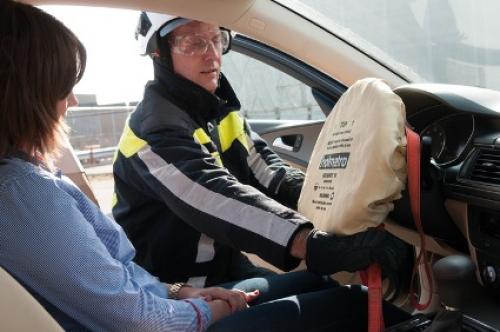Managing Risk
Happy New Year; I hope that 2015 brings health and happiness to you all.
My blog celebrates its second anniversary this week, but the video below from Dayton, Ohio is far older. This year it turns 21.
This incident happened in Dayton, Ohio, USA in 1994. Thankfully everyone involved made a full recovery.
I guess there are not many rescuers around the world who have not seen (or at least heard about) it. Most likely as part of their training when it comes to dealing with the potential risk from undeployed airbags on scene. It is one of the top three subjects I am asked about during training sessions and seminars (along with vehicle construction and hybrid vehicles).
Risk in Context
When discussing this topic, I always endeavor to try and put the issue in some kind of context.
Let me be very clear; the risk from undeployed systems and their components (e.g. inflators) is very real. Vehicles now have many more airbags than they did even 5 years ago, so in theory the risk is increasing.
The following steps must always be taken to ensure you work as safely as possible:-
- Early identification of undeployed systems and their location
- Isolation of 12v vehicle system
- Application of an airbag restraint device (see below)
- Minimizing exposure within the risk area (without compromising patient care)
- Peeling and removing all interior trim prior to cutting structural elements of the vehicle

Application of an Airbag Restraint Device
What I ask rescuers is this: With the exception of the video above, how many other confirmed incidents of this type have you heard of? The answer here is predominantly "None" (although some anecdotal stories are told).
In addition. I ask how many extrications from vehicles with multiple undeployed systems take place each and every day worldwide. The answer here is actually that nobody knows but many hundreds, if not thousands.
If such an incident did happen, we would very quickly become aware of it due to the prolific use of social media in our industry.
So should evolution change our perceptions of risk?
When I consider the above points, a few things immediately become clear to me:-
- Rescuers are far more aware of these systems and how to work safely around them than they were 21 years ago.
- Deployment of systems during extrication is a rare (but not impossible) event.
- The safety steps listed above are well known throughout the industry and are commonly practiced at the majority of extrications around the world (although not all). It is, in general, standard practice.
- Vehicle systems have advanced meaning the likelihood of such an occurrence is reduced e.g. auto 12v disconnect and rapid drain capacitors
- My point here is not to disregard the risks but maybe consider repositioning this issue in our list of priorities. There are more serious issues that are posing a very real threat to rescuers on scene and yet these questions are rarely (if ever) raised during my training sessions or seminars; the overriding concern from rescuers is always airbag systems.
The safety of rescue personnel is everyone’s priority and must remain so throughout all phases of every incident. My view is that we have the right knowledge, equipment and procedures to greatly control the hazard and therefore reduce the risk posed by such systems; maybe allowing us to slightly refocus on other safety critical tasks.
Remember,
As always, I welcome your comments.
Ian